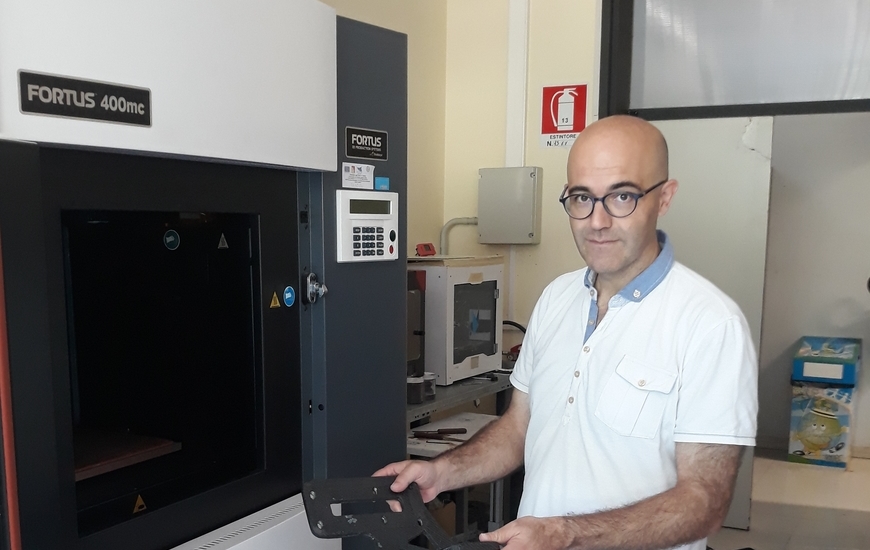Gianluca Cicala is professor of Materials Science and Technology at the University of Catania. He started his career carrying out an experimental master degree thesis on a novel toughening technology for RTM (patented as Priform) while at the Wilton Research Centre working with ICI and Cytec researchers. In 2008 he won, with his team, the international award Polymer Challenge for a novel technology for the production of auxetic composites. His main research focus are now on additive manufacturing, ecocomposites and polymer materials for medical devices. He published 89 papers certified on Scopus, 5 book chapters, 2 international patents and more than 90 oral communications to national and international conferences. CompositesPortal asked him what he thinks about the future of composites.
Professor, do you think that composite materials can be regarded as future materials?
"I am sure that composites, despite their actual intense and widespread use, are still to be considered as future materials. I would say materials with a bright future. Just to make an example, if we think about the increasing use of composites in the automotive sector, composites will be increasingly of interest not only for their lightweight but also as multifunctional materials capable, as they can, to have many other functional roles. We have already examples of composite materials that can act as capacitor or energy harvester".
What would you define the research frontiers for composites? What will be their future?
"There are many different research frontiers for composite materials. One, surely, is the development of multifunctional composites. This means that materials are under development where reinforcing fibers are blended or decorated with nanoparticles to obtain materials with added functionalities. For example, a common problems for aircraft in cold regions is represented by the deicing procedure which may cause flight delays. MIT researchers proposed the decoration of carbon fibers with carbon nanotubes to obtain self-heating composites that can avoid ice formation. Our research group proposed similar researches by developing soluble filled nanofibers to selectively disperse nanoparticles to create distribution gradients to achieve multiple functionalities. In addition to multifunctionality, a wide sector of industrial research is focused on the development of ecocompatible matrices and fibers to obtain green composites. Recently, I have visited the laboratories of Professor Maurice Collins at Limerick who is in charge for a very interesting European project named Libre on the production of carbon fibers from lignin as raw material. This research, together with the novel development of bio and recyclable matrices, could solve many problems concerning the sustainable use of composites in mass production sector like automotive. As an example in this field it is also worth mentioning the recyclable epoxy/amine sytems developed by the company Connora Technology on which our research group worked and published in the past with Connora’s researchers".
Do you see any novel application field for composites?
"It really depends on the composite’s type. If we focus on composites reinforced with continuous fibers the application spectra is not full. Just as a relevant example, in the automotive field, composites are still used in low volume production mostly. However, with the joined development of both automated production techniques and low cost materials a wider application of composites will be experienced. If we consider the medical sector, most applications nowadays regard external protheses only. However, with the novel surface treatments optimized internal protheses will be also manufactured. When composites embedding micro and nano particles are considered the scenario can be even wider. There is no sector that will not be impacted by such composites".
Do you believe in the additive manufacturing? Do you think 3d printers will have really an impact on our future?
"3D printing, or Additive Manufacturing (AM), is one of the most relevant and impacting technology for our future. However, some false myths on AM should be clarified first. Nowadays, there is no commercial printing techniques that can be competitive, in term of production time, with traditional techniques. The materials available on AM equipment are still limited if compared to those available for traditional approaches. If we focus on the 3D printing of matrices reinforced with continuous reinforcing fibers the market, at the moment, offers one solution only: MarkTwo by MarkForge. However, this printer is limited to the use on Nylon as matrix. Recently, two companies launched on the market two similar systems focused on the use of thermosetting matrices and continuous fibres: the American Continuous Carbon and the Italian Atropos. The commercial landscape is much wider if we consider themplastic matrices reinforced with short reinforcing fibers. The choice, in this case, can vary from systems that can process Nylon to PEEK, Polycarbonate, ABS etc. In the case of PEEK, I think it is relevant to stress the increasing importance gained on the marked by an Italian company (ndr. Roboze) with whom we cooperated in the past. Roboze is now a leader in their sector and with Carbon PEEK is finding its way in many applications were reinforced composites are needed. If we look at the impact on our everyday life, I think there are some observations deserving for a special interest. Google invested heavily on two companies involved with AM: Carbon and Metal Desktop. At the same time Google invested in solid modeler like SketchUp (https://en.wikipedia.org/wiki/SketchUp). What would be our future is Google would let us draw and print our objects? Jeremy Rifkin in one of his book pre-ecived distributed manufacturing systems with 3Dprinters readily available and open for use everywhere. Try to imagine the revolution of being able to draw and print on demand everywhere in terms of the lower environmental impact of reducing the transportation of finished goods…. I believe this could really be impacting all our life".
What will be, if any, the role of Italian and European research in the development of composite materials and in their applications?
"The Italian and European research is at the forefront in the composites and additive manufacturing fields. The Italian excellences have their sound foundations in a multiyear tradition on Academic research and manufacturing industry. Just to cite some of the most relevant cases we can cite Leonardo for the aircraft structures; Ferrari, Dallara and many others for the automotive fields; Azimuth in the naval sectors. In the academic sectors there are many examples of authoritative colleagues worldwide known. Just to cite one Professor Gino Nicolais, among the many different activities in the field, authored the new edition of the Encyclopedia of Composites for Wiley and also created the technological district IMAST with partners like Boeing, Cytec, FCA and Mapei. In Europe there are many research centers that gained a prominent position worldwide. In one world we can say that Europe will have a central role in the future of composites".
-

-
19 July 2019






















